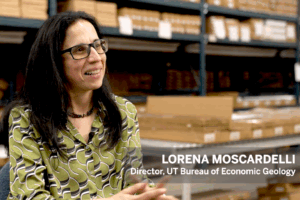AUSTIN, Texas—The challenge seemed daunting. Plan an intensive three-week seminar on computer-supported collaborative learning for 48 faculty members of the Monterrey Institute of Technology and Higher Education (ITESM) in Mexico. And, do it in only five weeks.
It proved to be another routine assignment for Dr. Paul E. Resta, professor of curriculum and instruction and director of the Learning Technology Center in the College of Education at The University of Texas at Austin.
An expert in the field, Resta has developed award-winning online instructional technology courses and was eager to help his Mexican colleagues learn and use these powerful techniques at their own schools. He assembled his planning team and got to work. With the help of UT’s International Office, the seminar soon was planned and organized.
The group who sought out Resta’s knowledge represents the 30 ITESM campuses located throughout Mexico. They arrived in Austin May 27 for the seminar, which runs through June 15. Each of the participants brought a laptop computer and a desire to improve their teaching and education at ITESM as a whole, with online collaborative methods.
Using a technique Resta has developed in other online courses, and which aptly demonstrates the collaborative approach, the students work in an online virtual environment, the Collaborative Technologies Center, exploring "real-world" issues and tackling realistic planning and management tasks.
As members of the center, they work together as part of a knowledge-building community. Their goal is to learn about, and develop their own, collaborative strategies so they can redesign their courses at ITESM and assist other faculty at their campuses to use these methods. Participants design several classroom activities, employing both face-to-face cooperative methods and online collaboration, as well as a professional development plan for their campus describing how they will train other instructors in these techniques.
Collaborative learning offers many benefits to the educational process. Talking and working with others to solve problems and make decisions facilitates learning and the achievement of deeper understanding. Online collaborative methods take the process a step further. "The online setting creates a dynamic, supportive learning community that engages students and exposes them to multiple perspectives," said Resta.
"ITESM is in the process of educational change, and collaborative learning is a key component of this," said Dr. Marisa Martin, director of research and educational development for the ITESM System. "We have come to learn from the successes of Dr. Resta and the other instructors. The activities of the seminar have been very well planned. With the collaborative nature of the content and the environment of the seminar itself, we are living the theory we are learning."
Assisting Resta with course instruction are Edythe Johnson Holubec, an expert in cooperative learning, and Marilla Svinicki, director of the Center for Teaching Effectiveness at UT Austin. The academic team who helped Resta plan and implement the course are Learning Technology Center staff Carolyn Awalt, Dongjoo Lee, Janey Wang, and graduate students Scott Gibby and Richard Pelton.
Just as important as the seminar has been in helping ITESM achieve its goals is the continuing cooperation planned for the months ahead. "We will collaborate online as they try out their instructional units, providing help and feedback," Resta said. Videoconferences with the group are planned, and Resta may travel to Mexico in the fall to monitor their progress and encourage their continued efforts.



